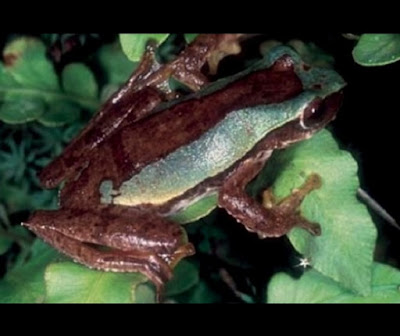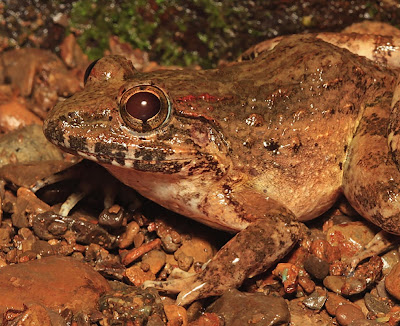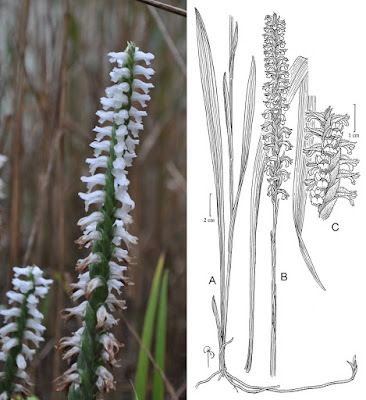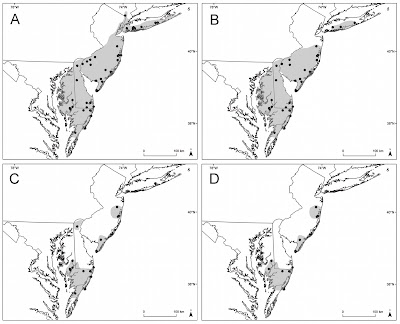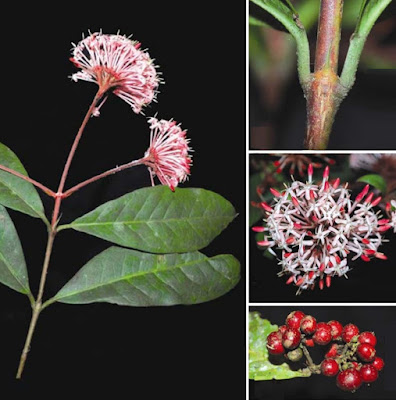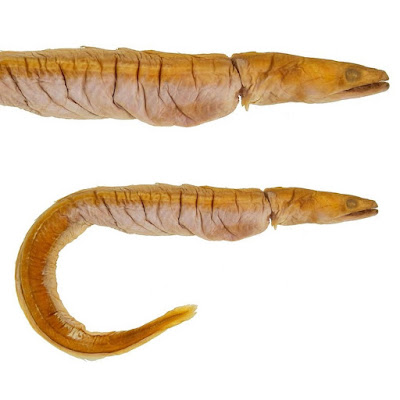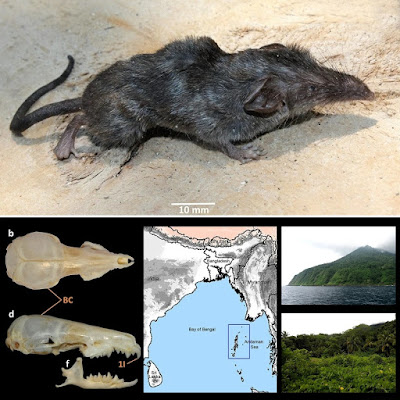[Most Recent Entries] [Calendar View]
Monday, May 3rd, 2021
| Time | Event | ||||||
| 6:03a | [Herpetology • 2019] Rhacophorus vanbanicus • A New Species of Rhacophorus Genus (Anura: Rhacophoridae) from Van Ban District, Lao Cai Province, Northern Vietnam
Abstract We describe a new species of the Rhacophorus genus, which differs from all species known in Asia by the combination of characters. It strongly differs also from small and middle-sized species of Rhacophorus sensu lato: Rhacophorus calcaneus Smith, 1924, Leptomantis cyanopunctatus (Manthey et Steiof, 1998), Rhacophorus hoabinhensis Nguyen, Pham, Nguyen, Ninh et Ziegler, 2017, Rhacophorus hoanglienensis Orlov, Lathrop, Murphy et Ho, 2001, Zhangixalus jarujini (Matsui et Panha, 2006), Rhacophorus laoshan Mo, Jiang, Xie et Ohler, 2008, Rhacophorus pardalis Günther, 1858, Rhacophorus rhodopus Liu et Hu, 1960, Rhacophorus robertingeri Orlov, Poyarkov, Vassilieva, Ananjeva, Nguyen, Sang, and Geissler, 2012, Leptomantis robinsonii (Boulenger, 1903), Rhacophorus spelaeus Orlov, Gnophanxay, Phimminith, and Phomphoumy, 2010, Rhacophorus translineatus Wu, 1977, Rhacophorus turpes Smith, 1940, Rhacophorus vampyrus Rowley, Le, Thi, Stuart et Hoang, 2010, Rhacophorus viridimaculatus Ostroshabov, Orlov et Nguyen, 2013 by having brown color with two green dorsolateral stripes starting at the groin level and connecting through the distal part of eyelid with green triangle on the head, slender body and head, lower ratio HW/HL 0.86, lower HW/SVL 0.28 and lower ratio HL/SVL 0.32. Keywords: amphibians; rhacophorid frogs; Rhacophorus sp. nov.; Northern Vietnam Rhacophorus vanbanicus Ivan I. Kropachev, Nikolai L. Orlov, Hoa Thi Ninh and Tao Thien Nguyen. 2019. A New Species of Rhacophorus Genus (Amphibia: Anura: Rhacophoridae: Rhacophorinae) from Van Ban District, Lao Cai Province, Northern Vietnam. Russian Journal of Herpetology. 26(6); 325-334. DOI: 10.30906/1026-2296-2019-26-6-325-334 | ||||||
| 6:12a | [Botany • 2019] Dahlia mixtecana (Asteraceae, Coreopsideae) • A Striking New Species from Oaxaca, Mexico
Abstract Dahlia mixtecana (Asteraceae, Coreopsideae) is described and illustrated as a new species endemic to western Oaxaca, Mexico. This taxon is related to Dahlia sect. Dahlia and Dahlia sect. Entemophyllon. However, based on the current evidence available and the current system of infrageneric groups, it does not appear possible to assign the new species with confidence to any taxonomic section. The description of the new species is presented with distribution maps, illustrations, photographs, discussions on the taxonomic relationship and an identification key to the sections and species of Dahlia occurring in Oaxaca and species in Dahlia sect. Entemophyllon related to D. mixtecana. Keywords: Compositae, Mixteca Alta, Tlaxiaco, Eudicots 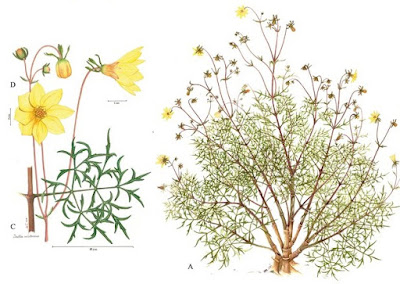 Dahlia mixtecana Reyes, Islas & Art. Castro sp. nov. Etymology:—The specific epithet refers to the Mixteca culture from Oaxaca, Mexico. Jerónimo Reyes-Santiago, María de los Ángeles Islas-Luna, Guadalupe Munguía-Lino and Arturo Castro-Castro. 2019. Dahlia mixtecana (Asteraceae, Coreopsideae), A Striking New Species from Oaxaca, Mexico. Phytotaxa. 394(3); 209–218. DOI: 10.11646/phytotaxa.394.3.2 | ||||||
| 7:32a | [Herpetology • 2021] Limnonectes beloncioi • A New, Morphologically Cryptic Species of Fanged Frog, Genus Limnonectes (Anura: Dicroglossidae), from Mindoro Island, Central Philippines
Abstract We describe a new species of fanged frog (genus Limnonectes) from Mindoro and Semirara Islands, of the Mindoro Pleistocene Aggregate Island Complex, of the central Philippines. Although morphologically indistinguishable from its closest relative, Limnonectes acanthi, of the Palawan faunal region, the two species can be readily diagnosed on the basis of spectral (dominant frequency) and temporal (pulse number and structure) properties of their advertisement calls, and their allopatric insular geographic ranges on permanently separate geological platforms which have not been connected by dry land in the recent geological past—all of which we interpret as congruent and independent lines of evidence supporting our recognition of two independently evolving evolutionary lineages (species). Ribosomal RNA mitochondrial gene sequences were used to provide genetic identification of specimens and estimate phylogenetic relationships; genetic divergences between Palawan and Mindoro faunal regions exceed those estimated among other, uncontroversial, phenotypically distinct Philippine species with equivalent levels of allopatry and biogeographic isolation. The recognition of the new species further emphasizes the degree to which even well-studied Philippine landmasses still harbor unrecognized biodiversity, and suggests that other widespread Philippine fanged frogs should be scrutinized for non-traditional diagnostic character differences (mate-recognition signal divergence, ecological differences, larval characteristics, life-history trait variation), especially when their geographic ranges span the archipelago's permanent, deep-water trenches, which define its well-characterized Pleistocene Aggregate Island Complexes.
Limnonectes beloncioi, new species Mindoro Fanged Frog Rana macrodon blythi Boulenger, 1920 (partim). Rana acanthi Taylor, 1923; Taylor and Elbel, 1958. Rana macrodon acanthi (Inger, 1954). Rana macrodon macrocephala (Inger, 1954) (partim: three Mindoro specimens [USNM] provisionally referred by Inger's “tentative identification” [Inger, 1954: 129]). Rana magna acanthi (Inger, 1958). Limnonectes (Limnonectes) acanthi Dubois, 1987 (partim). Limnonectes cf. acanthi Evans et al., 2003; Setiadi et al., 2010; Diesmos et al., 2015. Diagnosis and comparisons.— Limnonectes beloncioi is a medium-sized fanged frog, assigned to the genus Limnonectes (family Dicroglossidae), on the basis of its prominent, sexually dimorphic odontoid processes characteristic of the genus among other osteological synapomorphies (Inger, 1954, 1966; Emerson and Berrigan, 1993). The new species can be distinguished from all other known congeners based on a combination of its single-pulse/note advertisement call (vs. dual-pulses/note in L. acanthi from Palawan Island faunal region and PAIC landmasses), its phylogenetic position (sister to L. acanthi from Palawan PAIC; Evans et al., 2003; Setiadi et al., 2011), and its geographic distribution on Mindoro and Semirara Islands (vs. Palawan PAIC); it is the only species of Limnonectes known to occur on Mindoro and Semirara Islands and associated small satellite islands and, therefore, has no sympatric congeners. .... Etymology.—We derive the specific epithet, a patronym, to honor the Philippine army scout and freedom fighter Esteban Beloncio, who contributed substantially to the armed resistance against the Japanese WWII occupation of Mindoro Island, 1942–1945. Suggested common name = Mindoro Fanged Frog.
Distribution.—Limnonectes beloncioi is known only from Mindoro and Semirara Islands, central Philippines (Fig. 1). Minor land-bridge and deep-water islands to the east and southwest of Mindoro have not yet been surveyed for herpetofauna; as such, the identity of any populations of Limnonectes that might eventually be discovered on Ilin, Sibay, Ambulong, Caluya, Maestre de Campo, and/or the Cuyo Islands group cannot yet be confirmed. The genetic identification of populations of Limnonectes on Busuanga, Coron, and Culion (currently considered L. acanthi [Taylor, 1923, 1928; Inger, 1954; Brown and Alcala, 1970; Diesmos et al., 2015]; thus, we anticipate these populations will be more closely related to Palawan Island L. acanthi than to L. beloncioi) would be of particular interest to herpetologists, biogeographers, and speciation geneticists (Esselstyn et al., 2010; Brown et al., 2013). Mark W. Herr, Johana Goyes Vallejos, Camila G. Meneses, Robin K. Abraham, Rayanna Otterholt, Cameron D. Siler, Edmund Leo B. Rico and Rafe M. Brown. 2021. A New, Morphologically Cryptic Species of Fanged Frog, Genus Limnonectes (Amphibia: Anura: Dicroglossidae), from Mindoro Island, Central Philippines. Ichthyology & Herpetology. 109(1); 188-210. DOI: 10.1643/h2020095 | ||||||
| 8:46a | [Botany • 2021] Spiranthes bightensis (Orchidaceae) • A New and Rare Cryptic Hybrid Species Endemic to the U. S. Mid-Atlantic Coast
Abstract Recognizing species diversity is challenging in genera that display interspecific similarity and intraspecific variation; hybridization and the evolution of cryptic hybrid species amplifies these challenges. Recent molecular and morphological research focused on the systematics of Spiranthes (Orchidaceae) support hybrid speciation as an important driver of species diversity, particularly within the S. cernua species complex. Working under an integrated history-bound phylogenetic species concept, new molecular and morphometric data provide evidence for a new and rare cryptic hybrid species resulting from the ancient hybridization of S. cernua × S. odorata, here described as Spiranthes bightensis. Although S. bightensis is regionally sympatric with S. cernua it does not co-occur with that species, and it is allopatric with respect to S. odorata. Endemic to a narrow region extending from the Delmarva Peninsula to Long Island, New York, this new species occurs in the shadow of the Northeast megalopolis and appears to have undergone a major population decline over the last 200 years. By recognizing this distinct evolutionary lineage as a new species, this research is the first step towards developing conservation protocols for this rare species and highlights the importance of the North American Geologic Coastal Plain for biodiversity conservation and evolution. Keywords: evolutionary phylogenetics, North American Geologic Coastal Plain, Northeast megalopolis, Spiranthes cernua, Spiranthes odorata, species complex, Monocots Spiranthes bightensis M.C. Pace, sp. nov. [ancient S. cernua × S. odorata]. —Type: U. S. A. Maryland: Worcester County, Bainbridge Park pond, Ocean Pines, off of Beaconhill Rd., ca. 3.5 km west of Isle of Wight Bay, 23 October 2013, Pace 608 (holotype: NY, isotypes: K, US). Diagnosis. Spiranthes bightensis is most similar to S. cernua, from which it can be distinguished by its stoloniferous roots (vs. non-stoloniferous), typically longer and wider, more lanceolate leaves (vs. linear-lanceolate, 15–21.4 × 1.4–1.7 cm vs. 8.7–20 × 0.4–1.1 cm, Fig. 3, 4, Table 1) commonly fragrant flowers (vs. typically lacking fragrance), and slightly thickened central labellum (vs. centrally membranous). Spiranthes bightensis can be distinguished from S. odorata by its truncate column to rostellum transition zone, vs. lanceolate, and shorter and narrower leaves (15.0–21.4 × 1.4–1.7 cm vs. 13–51.7 × 1.8–2.7 cm). ... Etymology:— From the Old English / Anglo-Saxon ‘byht’, meaning bend or bay, a bight is a shallowly curved coastline or extremely wide bay; its use here refers to the Mid-Atlantic and New York Bights, which stretches from the Nantucket Shoals off southern New England southward to Cape Lookout, North Carolina. Spiranthes bightensis is endemic to the central region of this bight. Atlantic Ladies Tresses is the suggested common name. Matthew C. Pace. 2021. Spiranthes bightensis (Orchidaceae), A New and Rare Cryptic Hybrid Species Endemic to the U. S. Mid-Atlantic Coast. Phytotaxa. 498(3); 159–176. DOI: 10.11646/phytotaxa.498.3.2 | ||||||
| 10:07a | [Botany • 2016] Ixora predeepii (Rubiaceae) • A New Species from southern Western Ghats, India
Abstract Ixora predeepii, a new species of the family Rubiaceae from Southern Western Ghats, India is described and illustrated. It is allied to Ixora elongata Heyne ex D. Don in general appearance, but differs from the latter by its small habit, short peduncled congested inflorescence, small purplish white flowers with glabrous corolla and scarlet berry. Keywords: Ixora; New species; Rubiaceae; Southern Western Ghats.
Ixora predeepii Anoop et Harikrishnan, sp. nov. Diagnosis: Ixora predeepii sp. nov. is allied to I. elongata in its general appearance, many– flowered, congested inflorescence with pubescent peduncle and calyx, but clearly distinct from the latter by its small habit, comparatively small leaves, short peduncled congested inflorescence with small flowers, long calyx lobes, glabrous corolla and scarlet berry (Table 1). Etymology: Specific epithet of the new taxon is in honor of Dr. S.V. Predeep, Department of Botany, SVR NSS College, Vazhoor for his valuable contributions to the field of Angiosperm taxonomy. Habitat: Cardamom plantations and the margins of evergreen forests at 1100 m elevation. Anoop P. Balan and Harikrishnan Shanmugam. 2016. Ixora predeepii, A New Species of Rubiaceae from southern Western Ghats, India. Bangladesh J. Plant Taxon. 23(1); 65-69. DOI: 10.3329/bjpt.v23i1.28346 | ||||||
| 10:55a | [Ichthyology • 2021] Myroconger pietschi • A New Species of the Rare Genus Myroconger Günther, 1870 (Anguilliformes: Myrocongridae) from Brazilian Waters, Tropical western Atlantic
Abstract The family Myrocongridae comprises some of the rarest and least known benthopelagic eel species. It is composed of a single genus, Myroconger Günther, 1870, and five valid species: M. compressus Günther, 1870, from the Atlantic Ocean; M. gracilis Castle, 1991, M. prolixus Castle & Béarez, 1995, and M. nigrodentatus Castle & Béarez, 1995, from the Pacific Ocean; and M. seychellensis Karmovskaya, 2006, from the Indian Ocean. Herein, we report on an additional species from the Atlantic Ocean, Myroconger pietschi n. sp., based on a specimen obtained on the Aracati Bank, North Brazilian ridge, off Ceará State, western South Atlantic. Myroconger pietschi can be diagnosed by having 190 anal-fin rays, a short pectoral fin (16.6% HL), the posterior portion of the ethmovomerine teeth arranged in a single row, teeth on lower and upper pharyngeal tooth plate 24 and 27, and 10 branchiostegal rays. Keywords: Pisces, CT-Scan, Deep Sea, Elopomorpha, North Brazilian ridge, Northeastern Brazil Myroconger pietschi n. sp. Vinicius C. Espíndola, Rodrigo A. Caires, Kenneth A. Tighe, Mario C. C. De Pinna and Marcelo R. S. De Melo. 2021. A New Species of the Rare Genus Myroconger Günther, 1870 (Anguilliformes: Myrocongridae) from Brazilian Waters, Tropical western Atlantic. Zootaxa. 4965(3); 529–540. DOI: 10.11646/zootaxa.4965.3.7 instagram.com/p/CORQJvJB_h- @fishontherocks | ||||||
| 12:18p | [Mammalogy • 2021] Crocidura narcondamica • A New Mammal Species (Eulipotyphla: Soricidae) from Narcondam Volcanic Island, India
Abstract We discovered a new Crocidura species of shrew (Soricidae: Eulipotyphla) from Narcondam Island, India by using both morphological and molecular approaches. The new species, Crocidura narcondamica sp. nov. is of medium size (head and body lengths) and has a distinct external morphology (darker grey dense fur with a thick, darker tail) and craniodental characters (braincase is rounded and elevated with weak lambdoidal ridges) in comparison to other close congeners. This is the first discovery of a shrew from this volcanic island and increases the total number of Crocidura species catalogued in the Indian checklist of mammals to 12. The newly discovered species shows substantial genetic distances (12.02% to 16.61%) to other Crocidura species known from the Indian mainland, the Andaman and Nicobar Archipelago, Myanmar, and from Sumatra. Both Maximum-Likelihood and Bayesian phylogenetic inferences, based on mitochondrial (cytochrome b) gene sequences showed distinct clustering of all included soricid species and exhibit congruence with the previous evolutionary hypothesis on this mammalian group. The present phylogenetic analyses also furnished the evolutionary placement of the newly discovered species within the genus Crocidura. Mammalia Linnaeus, 1758 Eulipotyphla Waddell et al., 1999 Soricidae G. Fischer, 1814 Crocidurinae Milne-Edwards, 1872 Crocidura Wagler 1832 Crocidura narcondamica sp. nov. Diagnosis and description: The new species C. narcondamica sp. nov. (Fig. 1) is assigned to the genus Crocidura by the presence of three upper unicuspids and clearly distinguished from all other AN Archipelago shrews by its body size and tail length, which are considerably shorter (Supplementary Table S2). The new species possesses a darker-grey dense fur dorsally and a thick and darker tail (Fig. 1a), whereas the species known from the AN Archipelago possesses a different dorsal pelage and tail; C. jenkinsi (Supplementary Fig. S3a) and C. hispida have a spiny dorsal fur with a slender tail, C. andamanensis has a bluish-grey dorsal fur washed with brown and a darker brown tail, C. nicobarica has a bristly sooty brown dorsal fur with a slender tail, and C. attenuata has a soft brownish-grey dorsal fur with a slender tail2,51 (Supplementary Fig. S2a). ... Etymology: The new species is named for the type locality, Narcondam Island, where the type specimens were collected. The specific epithet is feminine latinized adjective. Suggested common name: Narcondam Shrew. Distribution and habitat: The new species is presently known only from its type locality, Narcondam Island, Andaman and Nicobar Archipelago, in the Bay of Bengal, India. It was collected from a littoral forest along the coastline at 11 m elevation. No anthropogenic disturbances were observed in the habitat except for a security post (Fig. 2). Manokaran Kamalakannan, Chandrakasan Sivaperuman, Shantanu Kundu, Govindarasu Gokulakrishnan, Chinnadurai Venkatraman and Kailash Chandra. 2021. Discovery of A New Mammal Species (Soricidae: Eulipotyphla) from Narcondam volcanic island, India. Scientific Reports. 11: 9416. DOI: 10.1038/s41598-021-88859-4 |
| << Previous Day |
2021/05/03 [Calendar] |
Next Day >> |
